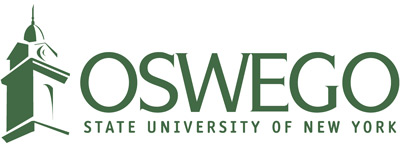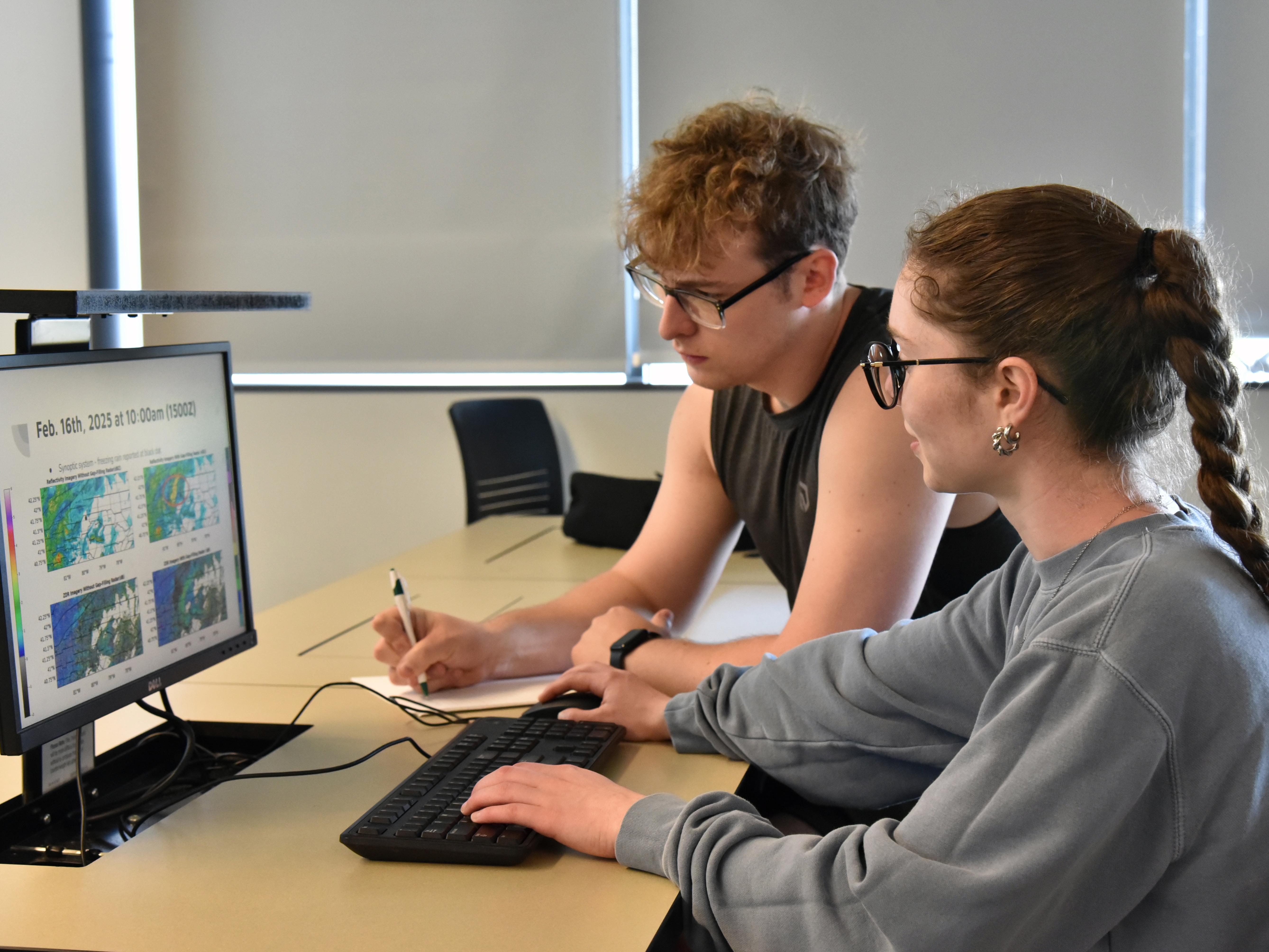Tom White and Zoe Bush, who just earned their meteorology degrees in May, look over data from their research with Climavision related to gap-filling radar.
Geographical gaps in radar coverage can limit the ability of meteorologists to forecast and communicate weather forecasts, especially with fast-developing and extreme conditions. Two May 2025 SUNY Oswego meteorology graduates, Zoe Bush and Thomas White, were part of research this spring on fixing these blind spots.
Bush and White examined data provided by supplemental weather radar coverage with smaller units, provided by Climavision, and found this technology could be especially useful for the lake-effect snow that impacts the Great Lakes region. Specifically, they analyzed data from a Climavision radar installation in Pleasantville, Pennsylvania.
“The company asked us to study how gap-filling radar would benefit forecasters, how it can benefit us,” as forecasters, as well as the public, Bush said. “They really provide radar coverage for blind spots, which is very valuable for lake-effect snow. This one particularly addresses a blind spot between Pittsburgh and Buffalo.”
White noted that these radar units are also better because traditional weather radar measures conditions higher in the atmosphere than lake-effect snow, which is closer to the ground.
“Snow squalls and lake-effect snow tend to be lower –- one to three kilometers above the ground –- than traditional events, like thunderstorms, existing radar might track,” White said. “Having more radar is good. They make supplemental radar, which always helps with forecasting.”
“We saw that in February, when we had whiteout conditions and you couldn’t see it on traditional radar,” Bush said. “The big challenge with lake-effect snow is that it can be as small as five kilometers wide and very localized, so existing models might not pick it up. And even a slight change in the wind direction, like 10 degrees, can move the band 10 to 15 miles.”
Climavision contacted professor Scott Steiger, knowing Oswego’s renowned meteorology program, and he recommended Bush and White, who co-led the program’s Lake Effect Snow Prediction and Research Center (LESPaRC).
LESPaRC provides predictions to a number of clients, including the New York State Department of Transportation (DOT), and Bush and White realize that more data can only enhance modeling and predictions that governmental agencies, schools and everyday people rely on.
The size of Climavision’s radar units can help build out the radar grid.
“They have gap-filling radar in the Northeast, but there are states out west with no or barely any radar coverage,” Bush explained. “This can be a solution. It’s only eight feet in diameter. They can even put it on top of a water tower.”
“They can work around terrains, towers and trees,” White said. “The best forecasts study the smallest areas, and the smallest forecast currently available is 3 kilometers. More radar data can help model forecasts. More research can generate that data.”
“The main thing is there just can’t be any taller structures around,” Bush said.
They wrapped up the project with a meeting in late May that “went quite well,” White said.
“I think they enjoyed the visual comparison of the impact of gap-filling radars,” White noted. "The Climavision company thought that it was well done and highlighted how the current NEXRAD radars often miss low-level weather phenomena such as lake-effect. Additionally, the gap-filling radar was able to better identify the location of the melting layer and thus have a better handle on mixed precipitation events.”
Building futures
This experience, coupled with their Oswego coursework and research projects, better prepared them for their graduate schools and careers beyond.
“I learned a lot about data, gained more experience plotting in Python, similar to NEXRAD,” White said of Next Generation Weather Radar, used by the National Weather Service, Federal Aviation Administration and U.S. Air Force, among others. “We learned about developing mosaics of radar, the compilation process and deciding what layers go on top.”
They are especially proud of at least one instance this winter where the student forecasts differed from the other services DOT incorporates, forecasting several fewer inches for Syracuse. This resulted in the students presenting to 30 members of DOT this year.
“We explained our thought process to them,” Bush said. “Since not everybody is a meteorologist, it’s important to make it understandable, make it simple. They had good feedback on what to improve, what they might want to see.”
The DOT also attended the May Climavision meeting and provided positive feedback on how the research and solutions could help improve their operations.
“Many studies, including this one, undeniably highlight a significant benefit towards meteorologists, DOTs and local governments for a reasonably low cost of data,” White said.
One discussion for the future involved Oswego students creating a lake-effect bulletin before a big event, presenting what to expect, where to expect it via maps and when to expect it.
“What really matters most is what time, where and how intense,” White said. And as he prepares for graduate school at the University of North Dakota, this is an area where he has gained substantial experience and expertise.
“Lake-effect is definitely my big interest,” White said. “I love lake-effect, that’s my focus. I did a lot of presentations on it senior year, including a senior capstone project and in classes. It’s preparing me for graduate school.”
“I feel like everything I’ve done here relates to lake-effect snow,” said Bush, whose other research included the university’s big Lake-Effect Electrification study.
“I prefer to work in the field, and SUNY Oswego provided me that experience,” added Bush, who will continue graduate studies at Texas A&M University, but not before being part of SUNY Oswego’s Storm Chasers program, traversing the country’s Tornado Alley from late May to mid-June researching and observing extreme weather.
“I’ve spent my time in Oswego doing what I love and it’s preparing me for the next level,” White said.




